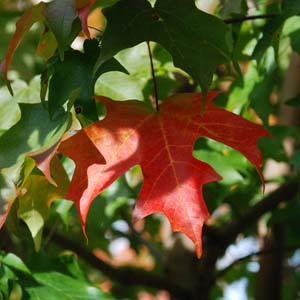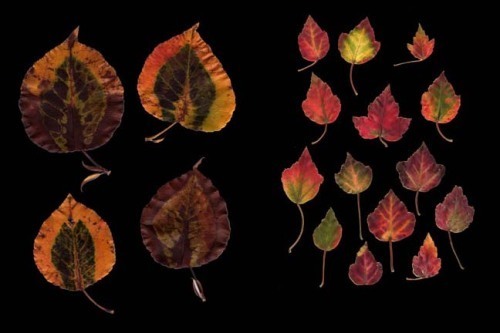Autumnal Tints
 Wednesday, February 4, 2009 at 05:37PM
Wednesday, February 4, 2009 at 05:37PM In the fall, I become fascinated with leaves. It's not so much their vivid changes of color, but their infinitely varying shapes that I find intriguing. But let's start with color, since this is the quality most people experience when they look at autumn trees.
We're struck by the vividness of the warm spectrum when leaves turn from green to red, yellow, and orange. We know that trees change color every autumn, but the experience still comes as an aesthetic surprise. Masses of red, yellow, and orange. The autumn spectacle. In Autumnal Tints, an essay published in 1862, Henry David Thoreau reported his observations about the changing colors of trees in and around Concord, Massachusetts as the fall progressed to winter. Thoreau was particularly taken with the color red. Vivid red maples appeared in the early fall: “the red maple is the most intense scarlet of any of our trees....A large red maple swamp, when at the height of its change, is the most obviously brilliant of all tangible things....”
The sugar maple rivaled the red maple in brilliance. At the end of the season, the scarlet oak displayed red foliage that matched the maples. Michael Sargent, who lives in Vermont, about 200 miles north and west of Thoreau's Concord, took a beautiful photograph of a sugar maple leaf in October 2008.

Looking at autumn trees from a distance, we tend to see only solid blocks of color. A closer view reveals variations in the coloring of individual trees. From up close, the leaves of an individual tree vary in their coloration. In the early stages of color change, leaves are often patterned in striking ways.
This fall I collected and scanned leaves that caught my eye because of the their individual color variations.

In this row of three leaves, the second, a white oak, displays the partial "de-greening" that occurs in fall as the green chloroplast cells die to reveal red that is a sign of anthocyanins, chemicals that help protect the leaf against receiving too intense light. The Wikipedia entry for anthocyanin tells more. I could not identify the first leaf, but its patterning is distinctive.
The third leaf is another from another white oak tree. (Notice how different it looks from its white oak neighbor. I will discuss leaf shape in follow up posts.) This leaf seems to be consumed by fire, with only its primary vein structure intact.

The first four of these two groups come from Bradford Pear trees. I have never seen leaves with such unusual patterns. The second group are Red Maple leaves. All these leaves were collected within a two to three week span in my neighborhood approximately eight miles southwest of Washington, D.C.


Reader Comments